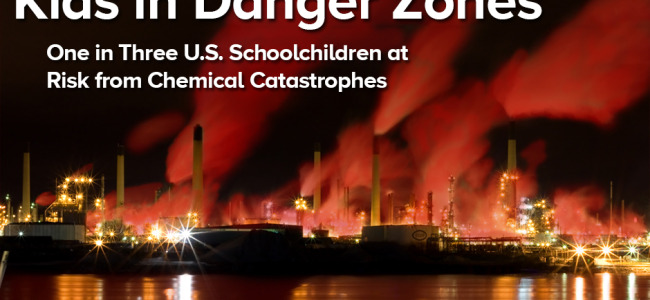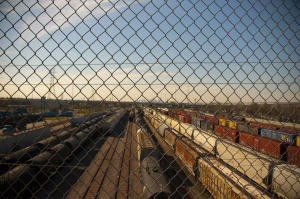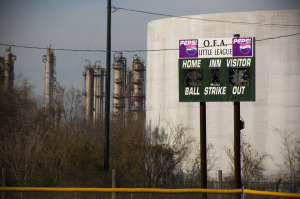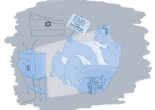
Duck, Get Smothered

By Bryan Parras
The Center for Effective Government recently released the report Kids In Danger Zones with the subtitle, “One in Three U.S. Schoolchildren Face Risk of Chemical Catastrophe.” A sobering number indeed, especially after a year of bomb trains, exploding warehouses, pipeline leaks and chemical disasters. The report looks at ‘vulnerability zones’ of industries making or transporting dangerous chemicals. It details the number of schools located in a facility’s impact zone should a deadly explosion occur. In Houston, 270 schools are sited in multiple vulnerability zones.
The report reminded me of an image a friend made at the Environmental Justice Workshop held this year in collaboration with the Environmental Protection Agency, TSU and t.e.j.a.s. The image developed out of a Theater of the Oppressed workshop held during the conference.
My friend created the image out of an early childhood memory at her elementary school. She attended Harris JR Elementary. The school is located at the foot of the Houston Ship Channel and sits across the street from one of the facilities featured in the report, Solvay USA Inc. This facility alone puts 714,446 students at risk of chemical exposure to fuming sulfuric acid (Oleum) in Harris County. Solvay’s own Product Safety Summary sheet says, “Oleum is dangerous to human health….[and] rapidly destructive to all body tissues.”
This is just one of dozens of possible worst-case scenarios for students attending schools in Houston and other surrounding school districts. The city of Deer Park has the school with the highest risk in the nation. “San Jacinto Elementary in Deer Park is located in the vulnerability zones of 41 different chemical facilities,” according to the report.
Thinking back on the conference and my friend’s image I wonder if the environmental professionals and government regulators that attended have reconsidered current emergency response plans that seem outdated and ineffective at addressing these potential catastrophic chemical disasters that seem to be happening more frequently.
It’s hard to justify the antiquated measures that schools employ in response to these serious threats. The following is a reflection on the workshop I conducted at the conference and a description of the students’ images that were created during the workshop.
Imagining Risk
“We are going to construct an image for you.” I’m at an Environmental Protection Agency (EPA) Environmental Justice Workshop in Houston, TX. I have been working with several young folks who would like to present their work. They have constructed a sculpture of their worst environmental fears and we are cutting into lunch and the keynote speaker’s time.
I rush to the center of the room and get the audience’s attention, introduce myself and tell the them that we are about to make a presentation. The image was produced using Theater of the Oppressed (TO). The process involves a range of theater exercises meant to disarm peoples’ fear of acting, build trust amongst a group of people and help articulate complex situations.
In TO, your body becomes clay, a piece of art waiting to be sculpted into real life situations representing critical moments of conflict. The images are meant to compel the spectators into action. There are no props, no backdrops and no costumes. You and the audience are left with the confines of your own imagination. TO can be done anywhere, even in the middle of a ballroom at an EPA conference.
Prior to this presentation, we were conducting a workshop with students and young adults interested in image theater. All of the breakout rooms were taken so we opted for the hotel lobby. I’m sure it was a bit strange for the staff and hotel guests who were checking in, but it fit our needs quite well.
This was one of many breakout sessions held during the conference and we were expected to report back with notes and recommendations to be included in the official notes. Since this was a kinesthetic workshop we decided to present our findings with a short performance in the main ballroom instead.
The students had a difficult time at first. We started with a series of preliminary theater exercises and then I instructed them to create an image of their worst environmental fear. They wanted more information. What did I mean by environment? Somebody asked me what I meant by worst environmental fear. I told them that it meant exactly what they thought it meant. Still a little confused, the students began to construct a series of images about everyday life in school.
The first sculpture depicted a person on the ground, crouched on the floor with her hands cradling her head. Three large bodies stood over her. One had his hand up about to strike the girl. Another person was about to kick the young girl in the abdomen. The last person stood watch, scowling overhead with his hands crossed over his chest. The participants were mute and static. The image is meant to speak for itself. I ask the sculptor to give it a name.
“Police brutality,” she said.
A waiter, walking past us in the lobby, noticed us and began to talk to the other waiters preparing the lunch buffet that was also being set up in the lobby.
“¿Que paso?” the waiter asked. We tell her that this is something students experience at school. She says, “Si, yo conozco. Tengo una hija en escuela ahora.” [“Yes, I know. I have a daughter in school now.”]
Another waiter came over and I started talking to the pair. They were interested in the image and wanted to know what we were doing. What did the girl on the floor do? Who were the people beating her? Who was going to help her? The image was working perfectly. The waiters were in the process of transforming into spect-actors. Most theater is designed for the stage where there are barriers that separate the actors from the audience but TO invites the audience to intervene.

In this case, she was a potential ally, a bystander, witness to a situation where several boys were bullying a young girl. She sympathized with the student being bullied but didn’t know what to do. Again, this was working exactly as designed. This process is meant not to provide answers but to help others think about solutions. What would you do in this situation?
The last sculptor looks determined and says that she remembers something that happened to her in elementary school. She already has a name for the image. I know her well. She is friend and colleague of mine.
She came to the U.S. when she was 6 and grew up in one of the most polluted communities in the city. She attended an elementary school near Manchester and recalls this drill that the students did over and over again while she was growing up. She grabs several volunteers and maneuvers them into place. I ask her to give each of the participants a phrase to say.
“Tell us what they are thinking,” I say.
When she’s finished, I ask her if she would like to share this in the ballroom as part of our report back. She nods her head in agreement. We head back to the main ballroom where I ask the keynote speaker if we can take a few minutes to present our notes to group. They give us 10 minutes.

I step away from the center of the room as she completes the sculpture. Four students are on their knees with their heads down and their hands clasped over their head. She has already put herself in the image. She is standing next to an adult or ‘teacher’ with a look of confusion on her face. The teacher has her hands up making the shape of a W. Her face is awkwardly defiant.
“Does this remind you of anything?” I ask the audience. People are standing up to get a better look. Some of the folks are attempting to take pictures without being overly conspicuous but nobody says a word. “Don’t worry, we already know how old you are from your registration?”
I hear a few chuckles and somebody yells out “Duck and Cover.” That’s right! I can tell that the audience is waking up but a little confused.
I ask the sculptor to name the image. She speaks into the mike, “Shelter in place.” I ask the other actors to remain in their positions. I ask my friend to tell us what each of the participants in the image is thinking.
One of them says, “I’m sacred,” another student says, “I want to go home.” The third student mumbles, “I don’t want to die.” I rush back to my friend and ask her what she is thinking.
“Why are we doing this?” she says.
Lastly, I ask her what the teacher is thinking. “I’m not sure if this is going to protect us.”
The teacher’s ambiguity is obvious from her posture, but not the confidence you would expect from a teacher. Yet, this is exactly the situation for hundreds of teachers and thousands of students across the district.
I ask the audience, “Would this have protected you from a nuclear bomb when you were a child? Raise your hand if you think it would. Would this protect these students now from a chemical explosion like the one we saw in West, TX. Would this protect you from a chemical disaster like the one in Bohpal, India?”
Its time to give up these recycled cold war risk management techniques that don’t work, look ridiculous, and lead to disaster impotence. I thank the audience for their time and remind them that this is exactly what students are living with right now. They expect us to protect them.











Pingback: DAILY DISPATCHES 10/17/14 | Fayetteville Free Zone()
Pingback: Kids In Danger | Texas Environmental Justice Advocacy Services()